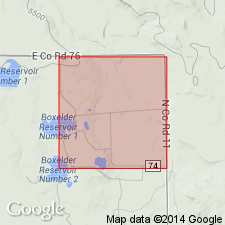
- Usage in publication:
-
- Terry sandstone
- Modifications:
-
- First used
- Dominant lithology:
-
- Sandstone
- AAPG geologic province:
-
- Denver basin
Summary:
First published use for a sandstone, unranked and one of five named unranked sandstones in the Mesaverde formation, exposed on an island in Terry Lake, Larimer Co, CO in the Denver basin. No type locality designated. Is 16 ft thick. Overlies and underlies unnamed shale of the Mesaverde. [No lithologic description given.] Cretaceous age.
Source: GNU records (USGS DDS-6; Denver GNULEX).
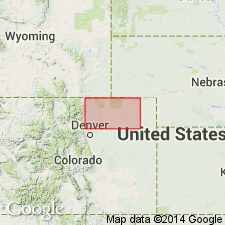
- Usage in publication:
-
- Terry sandstone member*
- Modifications:
-
- Revised
- Dominant lithology:
-
- Sandstone
- Shale
- AAPG geologic province:
-
- Denver basin
Summary:
Recognized as one of five sandstones reassigned as a member to the Pierre shale rather than as an unranked unit of the Mesaverde formation. Is separated from the older Hygiene sandstone member of Pierre by 200 to 400 ft of sandy shale with concretionary layers. Is separated from the younger Rocky Ridge sandstone member of the Pierre by 300 to 600 ft of shale. Is a 74 ft thick sandstone in beds 1 to 6 inches thick and sandy shale. Usually is 10 to 20 ft thick. Is much thinner and less persistent than the Hygiene. Geologic map. Not separately mapped from Pierre. Pierre forms extensive outcrops in Larimer, Morgan, and Washington Cos, CO in the Denver basin. Measured section. Late Cretaceous age.
Source: GNU records (USGS DDS-6; Denver GNULEX).
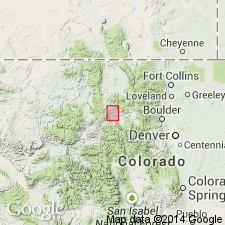
- Usage in publication:
-
- Terry Sandstone Member*
- Modifications:
-
- Overview
- AAPG geologic province:
-
- Denver basin
Summary:
Correlation of Upper Cretaceous Pierre Shale (and its Hygiene, Terry, Rocky Ridge, and Larimer Sandstone Members) near Boulder, CO in Denver basin with Pierre Shale (and its Sharon Springs, Kremmling, Muddy Buttes, Hygiene, Carter and Gunsight Pass Members) near Kremmling, CO, and with the upper part of Mancos Shale (and its Morapos and Loyd Sandstone Members) and with Iles Formation (and its Tow Creek and Trout Creek Sandstone Members) and Williams Fork Formation (and its Twentymile Sandstone member); the last two are formations of Mesaverde Group shown on fig. 2.
Source: GNU records (USGS DDS-6; Denver GNULEX).
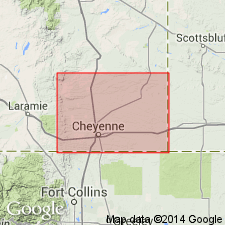
- Usage in publication:
-
- Terry Sandstone Member*
- Modifications:
-
- Areal extent
- AAPG geologic province:
-
- Denver basin
Summary:
Nomenclature applied to divisions of the Pierre Shale in exposures at Francis Ranch, secs 7-10 and 15-16, T14N, R69W and in subsurface in Apache Corp. 1 Polo Ranch, sec 14, T14N, R68W, Laramie Co, WY, Denver basin modified. Term: 1) Gammon Ferruginous Member replaces use of lower transition zone; 2) Mitten Black Shale Member replaces use of rusty zone; 3) Hygiene replaces use of the subsurface Sussex; 4) Rocky Ridge, Larimer, and Richard Sandstone Members replace use of the subsurface Parkman. Terry Sandstone Member of Pierre in the Fort Collins, CO area is equivalent to the subsurface Sussex and is not present at Francis Ranch or in the Apache Corp. well. Use of Shannon, Sussex, and Parkman is discontinued in the Denver basin because the sandstones of the Denver basin are not time-equivalents or time-transgressive facies of the Shannon, Sussex, or Parkman of the Powder River basin. As modified, divisions of Pierre are (ascending): Gammon, Sharon Springs, Mitten, Hygiene Members, unnamed interval, Rocky Ridge Sandstone Member, unnamed interval, Larimer Sandstone Member, unnamed interval, Richard Sandstone Member, unnamed interval, units A, B, C, unnamed interval. Pierre overlies Niobrara Formation and underlies Fox Hills Sandstone. Of Campanian age. Measured section; nomenclature chart.
Source: GNU records (USGS DDS-6; Denver GNULEX).
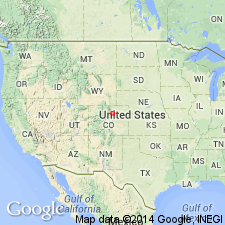
- Usage in publication:
-
- Terry Sandstone Member
- Modifications:
-
- Overview
- AAPG geologic province:
-
- Denver basin
Summary:
Is a sandstone in the middle part of Pierre Shale in the Denver basin that was deposited as an offshore shelf bar in shallow marine water south of the Parkman delta. South-tracking storms moved sediments from the delta front in south-central WY 80 mi south, depositing them over north-central CO. Four facies recognized: 1) sandstone; 2) sandstone; 3) bioturbated, sandy mudstone and muddy, non-burrowed, cross-stratified sandstone containing mudstone drapes; and 4) burrowed, cross-stratified sandstone. Is a coarsening-upward sequence. Diagenesis described. Cross sections. Of late Campanian, Late Cretaceous age. Name Sussex Sandstone Member [of Steele Shale] has been erroneously applied to this sandstone, which is younger than Sussex.
Source: GNU records (USGS DDS-6; Denver GNULEX).
For more information, please contact Nancy Stamm, Geologic Names Committee Secretary.
Asterisk (*) indicates published by U.S. Geological Survey authors.
"No current usage" (†) implies that a name has been abandoned or has fallen into disuse. Former usage and, if known, replacement name given in parentheses ( ).
Slash (/) indicates name conflicts with nomenclatural guidelines (CSN, 1933; ACSN, 1961, 1970; NACSN, 1983, 2005, 2021). May be explained within brackets ([ ]).

